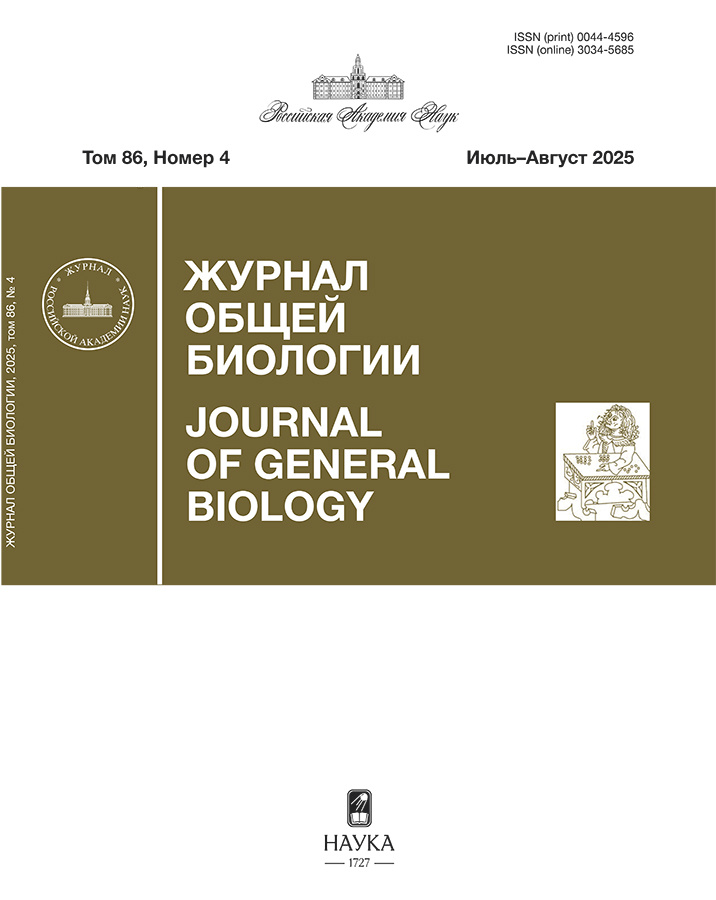Vol 86, No 4 (2025)
Articles
Analysis of the enemy release hypothesis based on the materialof the Central Russia flora
Abstract
The Enemy Release Hypothesis (ERH) is one of the most widespread explanations for the success of invasive species. It proposes that introduced plants are released from phytophages and pathogens in their secondary ranges, facilitating their expansion. However, literature reviews show conflicting results, and empirical support for the hypothesis remains limited. In this study, based on the flora of the Central European part of Russia (2550 species), we tested whether native, alien, and invasive species differ in the number of known natural enemies (herbivores and pathogens). The number of natural enemies was assessed at the genus and family levels using the Plant Parasites of Europe database. We found no significant differences in the number of natural enemies between native and alien plant species, nor between alien and invasive ones. Moreover, plants’ genera and families that include invasive species were characterized by a higher number of native species, which contradicts ERH expectations and supports the preadaptation hypothesis. The proportion of invasive species within a genus was positively correlated with the total number of species in that genus globally, possibly reflecting the influence of phylogenetic and ecological diversity on invasion likelihood. These results highlight the limited explanatory power of the Enemy Release Hypothesis and emphasize the need to consider multiple additional factors when analyzing the success of alien species.
Žurnal obŝej biologii. 2025;86(4):241-252
 241-252
241-252


Leaf bacterial microbiome of alpine plants in the NW Caucasus: factors of taxonomic diversity
Abstract
Endophytic bacterial communities in leaves participate in pathogen control, plant immune responses and the induction and mediation of stress resistance through the production of hormones and antioxidants. Understanding the composition, structure and factors influencing microbiome formation will enable us to consider plants as holobionts. Consequently, adaptation can be viewed not merely as a physiological and biochemical response, but rather as the ability of plants to shape the composition of their own microbiome. For the first time, data were obtained on the composition and structure of bacterial endophytes in the leaves of plants from four communities of the alpine belt of the Northwest Caucasus. These communities differed significantly in the number of bacterial taxa and the Shannon diversity index. However, no significant differences were observed between alpine snow bed communities and Geranium–Hedysarum meadows at various taxonomic levels. The factors studied had differing effects on abundant and less-represented bacterial taxa, often the factor has a significant effect only at the level of one group. The greatest influence on the composition of bacterial endophytes in plant leaves in the alpine communities was exerted by the community type and plant taxonomy. The contribution of the factors examined to the formation of leaf endophytic bacterial communities decreased in the following order: host plant taxonomy → community type → plant functional traits ≈ topographic factors.
Žurnal obŝej biologii. 2025;86(4):253-274
 253-274
253-274


Olfactory orientation in urodele amphibians
Abstract
The olfactory organ of Urodela amphibians appears to be phylogenetically ancestral type for terrestrial vertebrates. Due to their complex biphasic life cycle, these amphibians are an interesting object for studying olfactory orientation. The magnitude of movements of Urodela is not large, however, they can return to a breeding pond or home range from distances far exceeding natural movements. Olfaction potentially plays a significant role in this process. Laboratory experiments have shown the ability of newts and salamanders to discriminate between different odor sources: the water of breeding pond, shelters, and the scent marks of conspecifics. However, the results of field experiments which test directly the role of olfaction in the homing process are quite ambiguous. There is also still little data on natal philopatry and its mechanisms. It is not known whether Urodela have olfactory imprinting similar to that of fish and Anura. Although some evidences support the presence of imprinting. Further study of the olfactory orientation of Urodela will improve understanding of the evolution of this system in vertebrates and methods of amphibians conservation.
Žurnal obŝej biologii. 2025;86(4):275-298
 275-298
275-298


Transformation of Predatory Fishes Feeding Relationships in Alakol Lake System
Abstract
The introduction of pike-perch (Sander lucioperca) into Alakol Lake system (south–east of the Republic of Kazakhstan) and the ongoing acclimatization measures led to the transformation of fish community and changed the pattern of food relationships between predators. The native Balkhash perch (Perca schrenki) in the native fish community, being an optional predator, was at the top of the food pyramid. After naturalization, pike-perch acquired a higher trophic status, and perch began to play the role of an intermediate predator. There occurred an extension of the trophic network and the involvement of acclimatizing species in it. The increase in the numbers of pike-perch led to the “squeezing” of the Balkhash perch on freshwater lakes Sasykkol and Koshkarkol from the pelagic zone into the tributary system. This was facilitated by the availability of non-utilized resources of the native fauna, as well as its high reproductive potential. At the same time, the biomass of the alien in freshwater lakes increased faster than the food resource was produced and utilized, whereas in Lake Alakol this was prevented by environmental factors (mineralization). In the early 90s of the last century, the numbers of pike-perch in all lakes of the system stabilized, and since the early 2000s, high fishing pressure began to restrain its growth, which allowed Balkhash perch in freshwater lakes Sasykkol and Koshkarkol to increase their numbers and repopulate the pelagic waters of these water bodies. Regulation of pike-perch numbers opens up the possibilities of preserving the Balkhash perch as a unit of biological diversity. However, the detection of a catfish predator in the lakes of the system in 2024 may again curtail the process of restoring its numbers.
Žurnal obŝej biologii. 2025;86(4):299-322
 299-322
299-322












